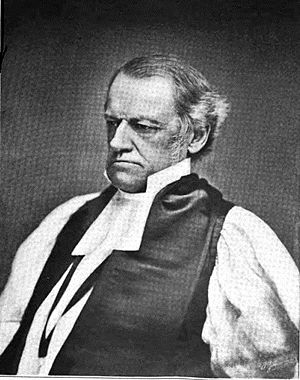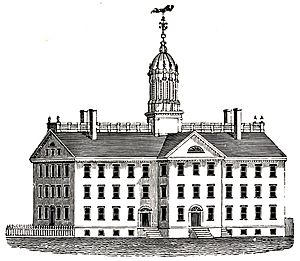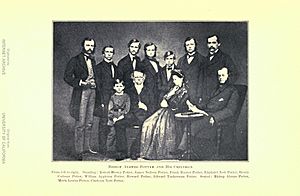Alonzo Potter facts for kids
Quick facts for kids Alonzo Potter |
|
|---|---|
| Bishop of Pennsylvania | |
 |
|
| Church | Episcopal Church |
| Diocese | Pennsylvania |
| Elected | May 23, 1845 |
| In Office | 1845–1865 |
| Predecessor | Henry Onderdonk |
| Successor | William Bacon Stevens |
| Orders | |
| Ordination | September 16, 1824 |
| Consecration | September 23, 1845 by Philander Chase |
| Personal details | |
| Born | July 6, 1800 Beekman, New York, United States |
| Died | July 4, 1865 (aged 64) San Francisco, California, United States |
| Buried | Laurel Hill Cemetery |
| Denomination | Anglican |
| Parents | Joseph Potter & Anne Brown Knight |
| Spouse |
Sarah Marie Nott
(m. 1824; died 1839)Sarah Benedict
(m. 1840; died 1864)Frances Seton
(m. 1865) |
| Children | 10 |
| Signature | |
Alonzo Potter (July 6, 1800 – July 4, 1865) was an important American bishop in the Episcopal Church. He served as the third bishop of the Diocese of Pennsylvania. People admired Bishop Potter because he supported many good causes in society.
Contents
- Early Life and Family
- Alonzo Potter's Education
- Religious Journey
- Teaching at Union College: 1821–1826
- Alonzo Potter's Marriages and Children
- Serving in Boston: 1826–1831
- Return to Union College: 1831–1845
- Bishop of Pennsylvania: 1845–1865
- Alonzo Potter's Impact
- Last Journey, Death, and Burial: 1865
- Honors and Legacy
- Works by Alonzo Potter
- Images for kids
- See also
Early Life and Family
Alonzo Potter was born on July 6, 1800, in Beekman, New York. He was the sixth child of Anna and Joseph Potter, a farmer. His family came from England and settled in Portsmouth, Rhode Island, in the 1600s.
Alonzo was related to the founders of Rhode Island, William Arnold and Roger Williams. Two brothers in the Potter family became bishops: Alonzo and his younger brother Horatio Potter. Alonzo's son, Henry Codman Potter, also became a bishop.
Alonzo Potter's Education
Alonzo first went to a local school in his hometown. He was a smart student but didn't enjoy reading much until he discovered The Life and Surprising Adventures of Robinson Crusoe. He loved the book so much that he couldn't stop reading it. After that, he said, "I took pleasure in books."
When Alonzo was twelve, he went to an academy in Poughkeepsie, New York. Three years later, his teacher said he was ready for college. At fifteen, Alonzo passed his entrance exam and enrolled at Union College in Schenectady, New York. He graduated with honors at eighteen in 1818. He even gave the Valedictory Oration at his graduation.
After college, Potter moved to Philadelphia to live with his brother, who was a bookseller. He continued his love for books and became interested in the Episcopal Church.
Religious Journey
While in Philadelphia, Alonzo Potter decided to join the Episcopal Church. He was baptized at St. Peter's Church. Later, Bishop White confirmed him at Christ Church, Philadelphia. Soon after, Potter decided he wanted to become a priest.
He started studying theology with Rev. Dr. Samuel H. Turner. He continued his studies when he returned to Union College as a tutor. Before returning to Union College, he also taught "colored persons." This showed his early commitment to equal rights for all people.
Teaching at Union College: 1821–1826
In 1821, Potter went back to Union College as a tutor. He quickly became a professor of Mathematics and Natural Philosophy.
While teaching, Potter became a Deacon in 1822, ordained by Bishop John Henry Hobart. At age twenty-four, he became a Priest in 1824, ordained by Bishop Thomas Church Brownell. After becoming a priest, he started a small church for black people in Schenectady and became their minister.
In 1823, Potter published his first book, A Tractate on Logarithms. This book showed he was a skilled mathematician. In 1825, Geneva College offered him its presidency, but he turned it down.
Alonzo Potter's Marriages and Children
Alonzo Potter married three times. He had ten children in total.
Sarah Maria Nott Potter
In 1824, Potter married Sarah Maria Nott, the only daughter of Eliphalet Nott, who was the President of Union College. Sarah Nott Potter passed away on March 16, 1839, shortly after giving birth to her seventh child, a daughter. Potter described her as someone who made everyone around her happy.
Sarah Benedict Potter
After Sarah Nott Potter's death, her cousin Sarah Benedict took care of the children. Alonzo married Sarah Benedict in 1840. They had three boys together. Sarah Benedict Potter was often ill and passed away in Philadelphia on January 29, 1864.
Frances Seton
In 1865, Potter married his third wife, Miss Frances Seton. They were married for only three months before he died on July 4, 1865. She passed away later in 1909 and left money to charities and religious groups.
Alonzo Potter's Children
Alonzo Potter had seven children with Sarah Nott and three with Sarah Benedict.
Children by Sarah Nott Potter
- Clarkson Nott Potter (1825–1882): A politician who served in the House of Representatives.
- Howard Potter (1826–1897): A New York City banker who helped many organizations like the Metropolitan Museum of Art.
- Robert Brown Potter (1829–1887): A General in the American Civil War and a financier.
- Edward Tuckerman Potter (1831–1904): An architect who designed the Nott Memorial at Union College.
- Henry C. Potter (1834-1908): A priest who became the seventh bishop of the Episcopal Diocese of New York.
- Eliphalet Nott Potter (1836-1901): A church rector, college professor, and president of three colleges.
- Maria Louisa Potter (1839-1916): Married sculptor Launt Thompson and lived in Italy.
Children by Sarah Benedict
- James Neilson Potter (1841–1906).
- William Appleton Potter (1842–1909): An American architect who designed many buildings.
- Frank Hunter Potter (1851–1932): Served as a first lieutenant in the American Civil War.
Serving in Boston: 1826–1831
In 1826, Potter became the rector of St. Paul's Church in Boston, Massachusetts. The church was struggling with disagreements and debt. Potter worked hard to help the church grow. He gave sermons, lectures, and visited church members. His sermons were clear and focused on Christian teachings. He also gave weekly "evangelical lectures."
Potter's work became too much for him, and his health suffered. In 1831, he resigned and returned to Union College to teach. His five years in Boston were very successful. He helped the church become united and prosperous.
Return to Union College: 1831–1845
In 1831, Potter returned to Union College as a professor. He taught many subjects, including philosophy, Greek, Latin, algebra, and geometry. In 1838, he became the college's vice-president. During this time, and later as a bishop, Potter was known as a national leader in education.
Potter turned down several important offers during this period. He declined a professorship at the General Theological Seminary in 1835. He also turned down an offer to lead Grace Church, Boston in 1835 and an election as a bishop in Massachusetts in 1838. His health was still not fully recovered, especially his voice.
Bishop of Pennsylvania: 1845–1865
In 1845, the Episcopal Diocese of Pennsylvania needed a new bishop. The previous bishop had resigned, and the diocese was divided. On May 23, 1845, Alonzo Potter was chosen. He accepted the role and was consecrated (officially made a bishop) on September 23, 1845, at Christ Church, Philadelphia.
The day after his consecration, Potter consecrated a new church. Within a year, he had visited almost every church in his large diocese.
Lowell Lectures in Boston
Potter had promised to give the Lowell Lectures in Boston. His diocese allowed him time to prepare and deliver these lectures. From 1847 to 1853, he gave five courses of lectures on "Natural Theology and Christian Evidences." These lectures were very popular, filling the largest auditorium in Boston. Potter gave them without notes, showing his great intelligence and knowledge.
Community Projects and Initiatives
Within a year of becoming bishop, Potter started many community projects that he believed the Episcopal Church should support.
The Academy
In 1846, Potter helped reopen the Academy of the Protestant Episcopal Church in Philadelphia. It became so popular that a new building was opened in 1850 for 150 students.
Convocation System
In 1846, Potter started the Convocation system. This system helped different ministers work together and promote missionary work more effectively than before.
Young Man's Institute
When Potter moved to Philadelphia, he noticed many young men without education or positive activities. In 1849 and 1850, he helped create the Young Man's Institute. This institute offered night schools, libraries, and reading rooms for young men over sixteen.
Clergy Daughters' Fund
In 1849, Potter announced the creation of the Clergy Daughters' Fund. This fund provided free scholarships for daughters of pastors who earned low salaries and lived where good schools were not available.
Church Hospital
Potter also helped establish "the Hospital of the Protestant Episcopal Church in Philadelphia." In 1850, a building was donated, and the hospital began its work. A new, larger building was started in 1860. By 1862, it was used to treat Union soldiers wounded in the American Civil War.
Training for Future Clergy
Potter saw the need to train future priests in Philadelphia who couldn't attend regular seminaries. In 1861, he founded the Philadelphia Divinity School to meet this need.
Health Challenges
In 1855, Potter first mentioned his "impaired health" to the Diocesan Convention. He said he might need to reduce his activities outside the church.
Winter in Florida
In the winter of 1855–56, Potter and his wife, whose health was also declining, spent time in Florida hoping the mild weather would help them recover. Potter wrote to his son Henry, saying he hoped the vacation would help him return to his work with renewed energy.
Trip to Europe: 1858
On February 10, 1858, Potter became very ill during a church service. His friends and the Diocese urged him to travel to Europe to recover. He spent time in England and France, but his health did not improve much. He returned looking tired and frail.
During his time in Europe, Samuel Bowman was elected as his assistant bishop, but he passed away soon after. In 1861, William Bacon Stevens was elected as the new assistant bishop.
Promoting Equality and Unity
Potter had always cared about the rights of black people. He taught "colored persons" in Philadelphia as a young man and continued this concern as a bishop.
Church of the Crucifixion
In 1845, Potter supported the founding of the Church of the Crucifixion in Philadelphia. This was an integrated church where both black and white people worshipped together. However, the church faced challenges when it tried to join the Diocesan Convention because it was mostly made up of people of African descent.
Bishop Potter strongly spoke out against the "prejudice and injustice" that tried to deny the church's admission. He believed in truth and justice for all.
Muhlenberg Memorial
In 1853, at a major Episcopal Church meeting, a group presented the "Muhlenberg Memorial." This document supported traditional church teachings but also asked for more freedom in beliefs and worship. It suggested that Episcopal bishops could ordain Protestant clergy who accepted basic Episcopal teachings.
Potter was a strong supporter of this Memorial. He believed the church should be open to different opinions and work towards Christian unity. He wrote that the church should embrace "large diversities of opinion."
Church Unity
Potter believed in unity both within the Episcopal Church and among different Christian denominations.
Unity within the Episcopal Church
Potter disliked strong disagreements within the church. He taught his son Henry to avoid judging those he disagreed with. Potter believed the Episcopal Church should welcome members with both "high church" (more traditional) and "low church" (more Protestant) views. He felt that the church should be a place of unity and peace.
Unity between Denominations
Potter thought the Episcopal Church should lead the way in bringing Christian churches together. He believed that unity should involve compromise from all sides.
Alonzo Potter's Impact
William Bacon Stevens, who became bishop after Potter, described Potter's many contributions. He was an educator, a church minister, a church leader, a philosopher, a helper of people, and a patriot.
Potter as an Educator
Potter was a leader in education. He worked to improve and expand public education. He helped form the American Association for the Advancement of Education, which was a forerunner of the modern National Education Association. He also wrote a book called The School and the Schoolmaster, which was widely distributed.
Potter as a Parochial Minister
Potter served as a church minister for five years in Boston. He took a struggling church and helped it become strong and successful.
Potter as a Church Leader
As a leader in the church, Potter was seen as wise and forward-thinking. He played an important role in church meetings and influenced new rules and ideas. He was a champion for more flexibility in church services.
Potter as a Philosopher
Potter was a deep thinker and understood many different philosophies. His Lowell Lectures showed that he was a very intelligent Christian philosopher.
Potter as a Philanthropist
Potter was a "benefactor of humankind," meaning he helped many people.
Temperance Movement
Potter was involved in the temperance movement, which aimed to reduce alcohol use. He gave lectures and wrote about the problems caused by excessive drinking. He believed it was important to prevent drunkenness.
Helping the Needy
Potter was active in helping the sick, the poor, and the disabled. He held positions in organizations like the Institution for the Deaf and Dumb and the Hospital of the Protestant Episcopal Church. He believed the church should create and manage these charitable groups.
Racial Equality
Potter's concern for black people was evident throughout his life. He worked to ensure "equal rights and opportunities" for all people, including the "colored race."
Potter as a Patriot
Potter was a strong supporter of his country. In 1848, he gave a speech about patriotism, emphasizing that nations are accountable to God, should avoid war, and need both law and liberty. He also stressed the importance of morality in society.
During the American Civil War, Potter strongly supported the United States government. After President Abraham Lincoln's Emancipation Proclamation, Potter saw the need to help newly freed people with food, education, and religious support.
Potter as a Bishop
Potter saw his role as a bishop as guiding the church, shaping important charities and schools, and mentoring clergy. He was respected by many Christian groups for his work. He showed great care and support for his clergy, helping them and their families.
Last Journey, Death, and Burial: 1865
On March 30, 1865, Potter began a trip to California, hoping to improve his health. He was active during the voyage, holding services and preaching. When the ship neared San Francisco on June 29, 1865, Potter became very ill. He was diagnosed with "malignant Panama Fever" and died on July 4, 1865.
His funeral was held in Christ Church, Philadelphia, on September 11, 1865, the same church where he had been consecrated bishop. He was buried in Laurel Hill Cemetery, Philadelphia.
Honors and Legacy
Alonzo Potter received honorary degrees and held important positions. He was a vice-president of the Pennsylvania Bible Society and a member of the American Philosophical Society. He also served as a Trustee of the University of Pennsylvania.
In Christ Church, Schenectady, N. Y., there are memorials to Potter, his wife, and their children.
Bishop Howe wrote in his 1871 Memoirs that Potter "identified himself with all the best interests of society." The Schaff–Herzog Encyclopedia of Religious Knowledge called Potter one of the best American preachers of his time. A 1933 biography stated that his twenty years as bishop of Pennsylvania were "probably never surpassed." He was considered one of the greatest bishops in Pennsylvania, second only to the Revolutionary hero, Bishop White.
Works by Alonzo Potter
Alonzo Potter wrote several books and edited collections of sermons and lectures.
Books
- No Church Without a Bishop, Or a Peep into the Sanctuary (1845)
- A Treatise on Logarithms (1823)
- The Uses and Advantages of Sunday Schools (1846)
- Occasional Services for Missionary Meetings, etc. (1861)
Sermons and Addresses
- A Sermon, Delivered in Christ Church, Hartford, Before the Connecticut Church Scholarship Society, Aug. 5, 1829 (1830)
- An Appeal in Behalf of Missions: A Sermon Preached... May 12, 1829 (1829)
- Christian Philanthropy: A discourse... January 13, 1833, before the African School Society (1833)
- An Address Delivered December 9th, 1835, before the Mechanics' Literary and Benevolent Society of Poughkeepsie (1836)
- Third and Fourth Charges to the Clergy of the Diocese of Pennsylvania... May 1851, and 1852 (1852)
- An Address to the Clergy and Laity of the Diocese of Pennsylvania... May, 1852 (1852)
- The Eleventh Annual Address to the Convention of the P.E. Church in Pennsylvania (1856)
Images for kids
See also
 In Spanish: Alonzo Potter para niños
In Spanish: Alonzo Potter para niños






